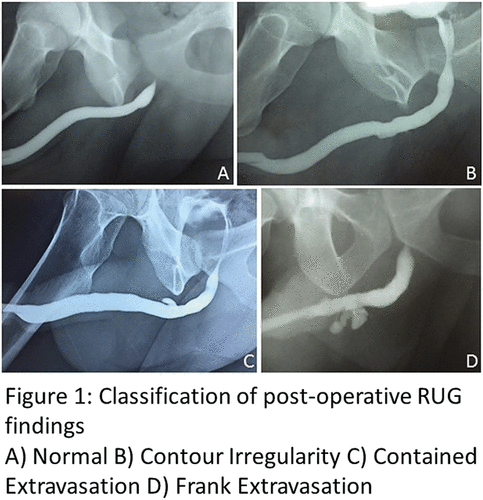Pelvic Trauma
Dr. Ferko
- Signs of pelvic trauma: hematuria, inability to void, abnormally positioned prostate
- Diagnosis:
- Hematuria, but severity of hematuria on UA does not equal severity of injury
- Plainfilms to evaluate for fx near kidney/bladder/urethra
- Retrograde urethrogram
- Retrograde cystogram
- Retrograde urethrogram-when?
- Male with external signs of trauma
- Perform ideally before foley placement
- Females-urology consult needed
- Defer if CTA pelvis needed as it will interfere with contrast
- Retrograde urethrogram-how?
- Patient supine
- Obtain baseline KUB
- 60cc syringe with 10% contrast, in last 10cc repeat KUB
- For stretch injury/partial disruption, usually conservative management with catheter
- Retrograde cystogram
- Fully fill bladder; inject until full and then 50cc further (usually around 400cc)

(from Journal of Urology)
Le Fort Fractures
Dr. Lehnig
- Complete or partial separation of mid face from skull
- Pterygoid involved in all
- Usually caused by blunt trauma
- LeFort I most common
- Higher velocity more likely to cause II/III
- LeFort I: palate-facial separation (think dentures)-mobility of the maxilla
- LeFort II: (nose and mouth) Nasal bridge, maxilla, lacrimal bones, orbital floor, and rim
- LeFort III: across nasal bridge, orbital walls, zygomatic arch (“floating face”)
- Endotracheal intubation preferred over nasal, prep for difficult airway
- LeFort II/III: CTA indicated
- Complications: Vascular injury (internal carotid as high as 7%), nerve injury, eye injury
- Treatment: definitive tx is surgical, ophtho consult, NES if CSF leak
- No specific guidelines on abx, many get augmentin

Prehospital Airway Management
Dr. Price
- Methods available? ET tube (oral or nasal), BVM (with OPA/NPA), supraglottic, needle cric (methods vary by state per state regulations)
- Variables to consider: patient (age, condition), provider (level, experience, training), setting (environment, distance)
- Study with 4 Key questions addressed
- BVM vs SGA
- BVM vs ETI
- SGA vs ETI
- Benefits and harms comparison based on pt type, technique, and devices
- Methods: 1990-2020, >9000 abstracts, 99 studies
- Results…inconclusive benefits, but harms: no difference in reported aspiration, airway trauma, regurgitation with any devices; BUT number of attempts less with SGA than ETI
- Conclusion: current evidence does not favor more invasive airway approaches based on survival, neurologic function, ROSC, or successful airway insertion
- More research needed, may be more useful to study ventilation management as it may reveal clinically relevant differences
Oral Boards Prep
Dr. Shaw
Learning Points:
- In every patient, unless something requires emergent intervention, perform physical exam head to toe
- Remember to request repeat vitals
- Use a systematic approach
- Primary survey in trauma:
- MARCH
- Massive hemorrhage
- Airway
- Respiration
- Circulation
- Hypothermia/Head injury
- Massive hemorrhage:
- Tourniquet: place proximal to bleed, write time of placement
- Twist tourniquet until you lose pulses in the extremity
- 2 inches, 2 hours
- 2 inches proximal to wound
- On for up to 2 hours (can be left up to 6 hours, but can have neurovascular damage)
- Airway:
- Oxygenate
- Ventilate (apnea)
- Protect airway (secretions, mental status)
- Clinical course (too agitated for CT)
- Respiratory:
- Rate, breath sounds, stridor, tracheal deviation, JVD
- Needle decompression can be done either anteriorly at mid-clavicular line or laterally at anterior axillary
- If needle decompression or chest tube for penetrating trauma, remember to place occlusive dressing over the initial injuries/wounds
- Circulation:
- BP, HR
- 14G (250ml/min) and 16G (150ml/min) peripheral IVs have higher flow rate than Cordis (130ml/min)
- Head Injury/Hypothermia:
- GCS, pupillary exam, neuro exam
- MARCH
- Primary survey for every trauma patient, every time
![Room9er ["Room Niner"]:](https://room9er.com/wp-content/uploads/2020/03/cropped-Screen-Shot-2020-03-08-at-3.16.16-PM.png)